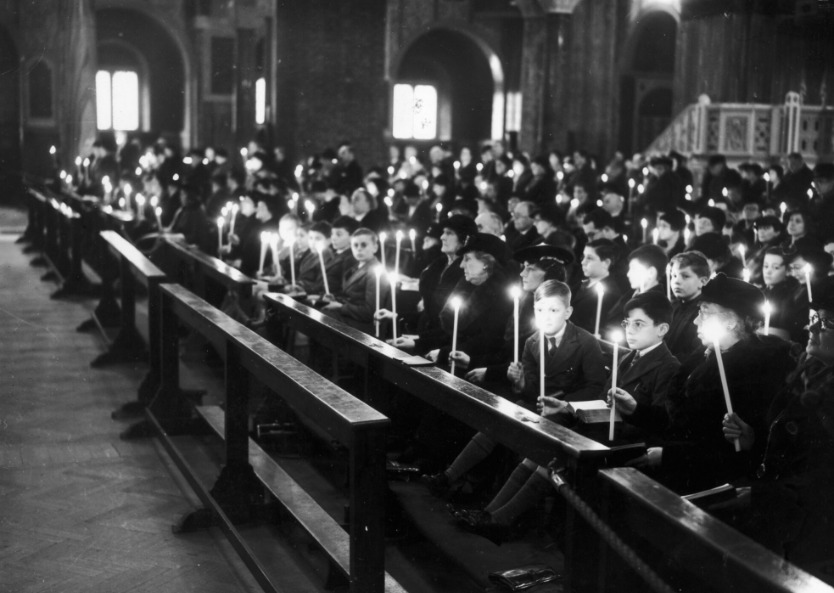Today's celebration of Candlemas reminds us of the balance between light and dark, and the natural order of things. The Presentation of Jesus in the Temple, which it commemorates – the fourth Joyful Mystery of the rosary – is tempered with sadness. Simeon prophesied to Mary that “a sword will pierce your heart". Sorrow and suffering are part of what it is to be human – they are as inescapable as darkness and light.
The third Joyful Mystery, the Nativity, is also overlaid with sorrow – the Magi’s gift of myrrh foretells the death of Jesus, and prepares Mary for her own important presence at the crucifixion. Myrrh was used in the embalming of the body; part of the process of grief involves attention to the corpse and its respectful treatment, the mortal coil in its final act.
It is rare now, but not unheard of, for a body to be laid out in the home, wearing its best clothes, with candles and flowers soothing the mourners, offering people time to sit still and to think about the life that has passed.
Then there is the wake, particularly in the Irish tradition, which involves staying up the night before the funeral to keep the corpse company – with the help of strong liquor. These events are powerful unifiers in any family or community, and give assurance, or at least hope, in our own dignified exits. My children filled their grandfather’s coffin with branches of cherry blossom, the care taken with the dying leading seamlessly to the respectful care of the corpse.
A traditional funeral manages to balance sorrow and joy. Along with the black clothes, the weeping and the presence of the dead there is the eulogy, the good words to remind the mourners of the value of the dead person’s life. A good eulogy will raise the spirits at a time of sadness; there may be uplifting hymns and perhaps the 23rd Psalm: “Yea, though I walk through the valley of the shadow of death I will fear no evil: for Thou art with me, Thy rod and Thy staff they comfort me.”
The promise of joy in the afterlife offsets the suffering of death and loss; the gathering of family and friends gives comfort.
That said, advertising leaflets from a company called Pure Cremation have started to land on my doormat: a sign of age, indeed. The adverts show cheerful gatherings of healthy people raising glasses of champagne. Their selling-point is that, after death, your loved one’s corpse will be taken away by the company and cremated without the presence of any family or friends. The ashes can be claimed after the event, but this is optional.
The leaflets claim that this takes the pressure off loved ones at a difficult time and frees them up to celebrate the life of their loved one at their convenience: the website suggests a games night or a country walk. It is also much cheaper – £1,500 rather than the average cost of a funeral, which is now about £5,000. There is no need, they explain, for either emotional or financial suffering.
These funerals are becoming increasingly popular in an age of secularism – in 2024, 1 in 14 funerals was without mourners. Now there is a move towards the “living funeral”, a ceremony without a dead person of any kind – a party that you organise yourself when death approaches. Companies such as Ceremonia offer help with these, for a price.
Publicity material shows more relentlessly cheerful people yet again raising glasses, this time in the company of an elderly person – not in good health but still presentable at a party. The caption reads, “The Party of your Life!” The reality of suffering as part of life or of dying itself, is kept from us. It is tempting to make a connection between the unattended funeral, to avoid mental suffering, and the move towards assisted suicide – death at a point of convenience, to avoid pain.
World religions recognise the importance of finding a place for adversity – the practice of Tonglen in Buddhism is about the receiving and transforming of suffering, for example. The Qu’ran, too, is clear that "If adversity befalls him and he is patient, this too brings good to him". Greek tragedy, the ancient epics and the Norse sagas recognise the catharsis in suffering. Shakespeare’s tragedies present us with both the darkness and the radiance in human nature and the ways in which we often bring about our own tragic endings. The texts force us to look at these things and our own capacity for compassion deepens as a result.
The Mass, too, transforms suffering in a very particular and sacramental way – death becomes life. As CS Lewis wrote, “Try to exclude the possibility of suffering, which the order of nature and the existence of free will involve, and you find that you have excluded life itself.”
Simeon blessed the Holy Family in the Temple, assuring them of joy in their lives, but also warned of the suffering to come. Luke doesn’t tell us how Mary received his gloomy prophecy, but she must have remembered it as she stood at the foot of the Cross.
<em>Photo: The congregation at a Candlemas service in Westminster Cathedral, London, 2 February 1938. (Photo by A. Hudson/Topical Press Agency/Getty Images.)</em>
<em>Camilla Harrison is a children’s catechist in the Diocese of Shrewsbury</em>.
<strong><strong>This article appears in the February 2025 magazine edition of the <em>Catholic Herald</em>. To subscribe to our thought-provoking and high-calibre magazine and have independent, counter-cultural and orthodox Catholic journalism delivered to your door anywhere in the world click <a href="https://catholicherald.co.uk/subscribe/?swcfpc=1"><mark style="background-color:rgba(0, 0, 0, 0)" class="has-inline-color has-vivid-cyan-blue-color">HERE</mark></a></strong></strong>.



